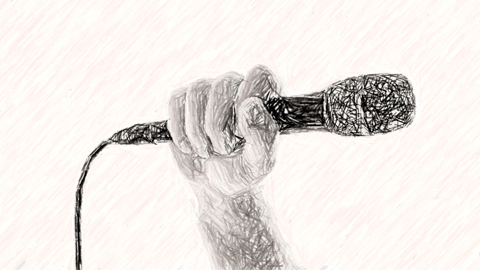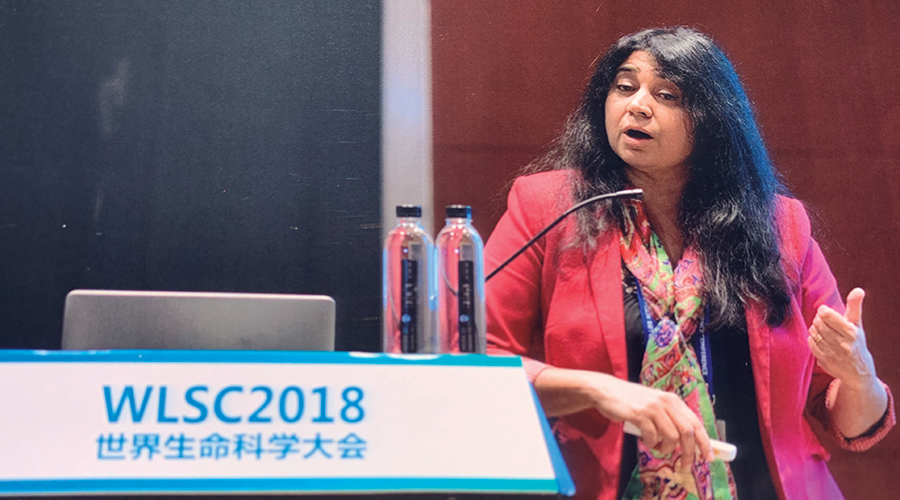Use the mic!
The glowing introduction is done. There follows a smattering of anticipatory applause. You stride confidently to the podium and wave away the microphone, saying, “I’ll speak loudly; can everyone hear me?” A few heads in the front row nod in assent, and you launch into your talk.

Don’t be this person. Use the microphone.
You may be surprised to learn that up to 20% of the population has some degree of hearing loss, making it the third most common physical condition, after arthritis and heart disease, according to the Hearing Loss Association of America. Deafness gets progressively worse with age, affecting approximately one in three people between the ages of 65 and 74. More women, relative to men, find it hard to hear lower frequencies.
When you decline to use the microphone, you are projecting your ableism, not your voice, by assuming that able-bodied people are the norm. If not, you reason, why wouldn’t they speak up? But people with disabilities often are exhausted from the constant need to self-advocate. Perhaps they don’t wish to bring attention to themselves.
When your audience cannot hear you, they cannot fully participate. Rather than engage with your data or your ideas, they struggle to make out the words. When you use a microphone, this cognitive burden is gone, and now everyone can focus on your splendid research! It’s a win-win for all.

Here are some tips on using the microphone effectively:
- Listen to your own voice projecting through the speakers, and adjust accordingly.
- When using a lapel mic, check what side of the screen you’ll be standing on and wear the mic on the side you’ll turn toward when you look at the screen; wear it high enough to accommodate your turned head, and remove chains or badge ribbons that may interfere.
- A hand-held mic must be kept at a steady distance from your mouth at all times.
- A podium mic should be adjusted for your height.
Investing just a few minutes to set yourself up for an effective broadcast could make or break your success as a speaker.
Other practices that will ensure inclusion:
- Additional microphones for questions from the audience are good, but if there aren’t any, be sure to repeat the questions using your microphone.
- The judicious use of labels and headings on your slides, large enough to be seen at the back of the room, adds another layer of comprehension.
- If you are a moderator or session chair, it’s your job to ensure that multiple people aren’t talking at the same time and making it harder to tune in on any one voice.
For more tips and firsthand insights on how to give a hearing-friendly and inclusive talk, watch “Like the mic,” a short video distributed by Rooted in Rights and the Hearing Loss Association of America.
The next time you come up to the podium to give a talk, don’t say, “I don’t need the microphone.” You may not, but someone in your audience does.
Enjoy reading ASBMB Today?
Become a member to receive the print edition four times a year and the digital edition monthly.
Learn moreFeatured jobs
from the ASBMB career center
Get the latest from ASBMB Today
Enter your email address, and we’ll send you a weekly email with recent articles, interviews and more.
Latest in Careers
Careers highlights or most popular articles

Exploring the link between lipids and longevity
Meng Wang will present her work on metabolism and aging at the ASBMB Annual Meeting, March 7-10, just outside of Washington, D.C.

Upcoming opportunities
Calling all biochemistry and molecular biology educators! Share your teaching experiences and insights in ASBMB Today’s essay series. Submit your essay or pitch by Jan. 15, 2026.

Defining a ‘crucial gatekeeper’ of lipid metabolism
George Carman receives the Herbert Tabor Research Award at the ASBMB Annual Meeting, March 7–10, just outside of Washington, D.C.

Building the blueprint to block HIV
Wesley Sundquist will present his work on the HIV capsid and revolutionary drug, Lenacapavir, at the ASBMB Annual Meeting, March 7–10, in Maryland.

Upcoming opportunities
Present your research alongside other outstanding scientists. The #ASBMB26 late-breaking abstract deadline is Jan. 15.

Designing life’s building blocks with AI
Tanja Kortemme, a professor at the University of California, San Francisco, will discuss her research using computational biology to engineer proteins at the 2026 ASBMB Annual Meeting.

